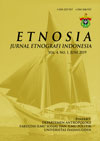Abstract
The purpose of this reseach is to explore, and categorize verbal and non verbal communication behavior in the performances of street children and beggars in Makassar. This study explored the operational actions and motivations of street children and beggars who work the streets. This study uses a qualitative method that seeks to interpret the meaning of data to understand a community's social life. The ethnographic approach to communication studies focuses on studying the interactions and activities of individuals as social creatures in using verbal and non-verbal symbols. Primary data collection was carried out through in-depth interviews with 21 street children informants and beggars operating in three sectors, namely, the Panakukang/ Fly Over/Red Light Sector, the Losari Beach Platform Sector, and the Hertasning Sector. Non-participant observation by repeatedly observing themselves both verbally and non-verbally in performing actions and actions in front of benefactors. This study found verbal and non verbal communication behaviors that are displayed as a form of impression management on the front stage in attracting the sympathies of benefactors. Verbal communication behavior in the form of spoken and written language based on categorical finding verbal symbols of street children and beggars using three elements, namely the structure of the message, the style of the message, and the attractiveness of the message. Furthermore, the categorization of non-verbal communication behaviors is facial expressions, body movements (kinetic), physical appearance (body and manner of dress), and paralinguistic(vocalic).References
Azwar, Z. (2015). Penyusunan Skala Psikologi.Yogyakarta: Pustaka Pelajar.
Arier, A. (2002). Upaya Pemberdayaan Anak Jalanan. http://anjal.blogdrive.com/archive/11.html diakses pada tanggal 15 Mei 2017.
B.S. Bambang. Meninos de Ruas dan Kemiskinan, Child Labour Cornes Newsletter.(1993) hal. 9.
Bajari, A. (2012). Anak Jalanan, Dinamika Komunikasi dan Perilaku Anak Menyimpang. Bandung: HumanioraBungin, H.M Burhan, 2008. Sosiologi Komunikasi (Teori, Paradigma, dan Diskursus Teknologi Komunikasi di Masyarakat). Jakarta: Prenada Media Group.
Denzin, Norman K. and Yvonna, Lincoln. (1994). Handbook of Qualitative Research. California z: SAGE Publications, Inc.
Departemen Sosial RI, Petunjuk Teknis Pelayanan Sosial Anak Jalanan, (Jakarta: Departemen Sosial Republik Indonesia, 2005), hal 20
Goffman, Erving. (1959). The Presentation of Self Everyday Life. Garden City N.Y : Double Day.
Hall, J.A., & M.L. Kapp, (1992). Nonverbal Communication in Human Interaction (3rd ed.). New York : Holt Rinehart and Winston, Inc.
Hattie, J. (1992). Self-Concept. Hillsdale, NJ : Lawrence Erlbaum.
Hayakawa, SI. “Simbol-Simbol” Dalam Deddy Mulyana dan Jalaluddin Rakhmat, ed. S. (1996). Komunikasi Antarbudaya : Panduan Berkomunikasi dengan Orang-orang Berbeda Budaya. Bandung : Remaja Rosdakarya.
Hare, A. Paul. Herbert H. Blumberg, Erving Goffman, David A. Snow, Louis A. Zurcher, Robert Peters, R. S. Perinbanayagam, Ronny E. Turner, & Charles Edgley. (1998). Dramaturgical Analysis of Social Interaction. New York : Praeger Publishers.
Kuswarno, E. (2009). Metodologi Penelitian Komunikasi “Fonomenologi” (Konsepsi, Pedoman, dan Contoh Penelitiannya). Bandung: Widya Pedjajaran.
Kurnia Ningsih. Komunikasi Sosial Anak Jalanan (Studi Fenomenologi terhadap Anak Jalanan di Kota Makassar)http://repositori.uin-alauddin.ac.id/10272/1/Komunikasi%20Sosial%20Anak%20Jalanan%20%28Studi%20Fenomenologi%20terhadap%20Anak%20Jalanan%20di%20Kota%20Makassar%29.pdf.
Littlejohn, S.W.S. (1996). Theories of Human Communication. Edisi ke-3. Belmont California : Wadsworth Publishing Company.
Moran, D. (2000). Introduction to Phenomenology. New York : Routledge.
Mulyana, Deddy & Solatun. (2007). Metode Penelitian Komunikasi (Contoh-Contoh Penelitian Kualitatif Dengan Pendekatan Praktis). Bandung : Rosdakarya
__________.2005. Komunikasi Efektif (Suatu Pendekatan Lintasbudaya).
Nasruddin, S.H. (2012). Ekploitasi Anak Jalanan (Studi Anak Jalanan di Pantai Losari Kota Makassar). Skripsi. Fakultas Ilmu Sosial dan Ilmu Politik. Universitas Hasanuddin Makassar.
Silverman, D. (2006). Doing Qualitative Research. Edisi ke-2. London : Sage Publications
Widjaja. (2006). Permasalahan Anak Jalanan Usia Anak-anak Akhir (10-12 tahun) sebagai Pengamen untuk Membantu Keluarga. Jakarta. Unika Atma Jaya. Peraturan Daerah Nomor 2 Tahun 2008 tentang Pembinaan Anak JalananUndang-undang Nomor 23 Tahun 2002 tentang Perlindungan Anak
Wallace, W. (1979). “An Overview Of Elements In The Scientific Process”. Dalam John Bynner dan Keith M. Stribly (ed), Social research : Principles and Produces. New York : Longman In Association With The Open University Press, hlm. 4.
http://news.rakyatku.com/read/116761/2018/08/30/dinsos-makassar-klaim-jumlah-anak-jalanan-dan-gepeng-turun-sepanjang-2018. diakses 10 Juli 2019.
http://news.rakyatku.com/read/145170/2019/03/27/332-anjal-dan-pengemis-di-makassar-dijaring-kebanyakan-dari-jeneponto. diakses 10 Juli 2019.





